Virtual Monoenergetic Imaging of Lower Extremities Using Dual-Energy CT Angiography in Patients with Diabetes Mellitus
Abstract
1. Introduction
2. Material and Methods
2.1. Study Population
2.2. DECT Scan Protocol
2.3. Image Reconstructions
2.4. Objective Image Evaluation
2.5. Qualitative Image Analysis
2.6. Statistical Analysis
3. Results
3.1. Population Characteristics
3.2. Quantitative Assessment
3.3. Qualitative Image Analysis
4. Discussion
Author Contributions
Funding
Institutional Review Board Statement
Informed Consent Statement
Data Availability Statement
Conflicts of Interest
Abbreviations
| ATA | Anterior Tibial Artery |
| CKD | Chronic Kidney Disease |
| CNR | Contrast-to-Noise Ratio |
| CTA | CT Angiography |
| DECT | Dual Energy CT |
| DM | Diabetes Mellitus |
| FA | Fibular Artery |
| PAD | Peripheral Arterial Disease |
| PTA | Posterior Tibial Artery |
| ROI | Region of Interest |
| SD | Standard Deviation |
| SNR | Signal-to-Noise Ratio |
| VMI | Virtual Monoenergetic Image |
References
- Galicia-Garcia, U.; Benito-Vicente, A.; Jebari, S.; Larrea-Sebal, A.; Siddiqi, H.; Uribe, K.B.; Ostolaza, H.; Martin, C. Pathophysiology of Type 2 Diabetes Mellitus. Int. J. Mol. Sci. 2020, 21, 6275. [Google Scholar] [CrossRef]
- Dal Canto, E.; Ceriello, A.; Ryden, L.; Ferrini, M.; Hansen, T.B.; Schnell, O.; Standl, E.; Beulens, J.W. Diabetes as a cardiovascular risk factor: An overview of global trends of macro and micro vascular complications. Eur. J. Prev. Cardiol. 2019, 26, 25–32. [Google Scholar] [CrossRef]
- American Diabetes, A. Peripheral arterial disease in people with diabetes. Diabetes Care 2003, 26, 3333–3341. [Google Scholar] [CrossRef]
- Brand, F.N.; Abbott, R.D.; Kannel, W.B. Diabetes, intermittent claudication, and risk of cardiovascular events. The Framingham Study. Diabetes 1989, 38, 504–509. [Google Scholar] [CrossRef]
- Gross, J.L.; de Azevedo, M.J.; Silveiro, S.P.; Canani, L.H.; Caramori, M.L.; Zelmanovitz, T. Diabetic nephropathy: Diagnosis, prevention, and treatment. Diabetes Care 2005, 28, 164–176. [Google Scholar] [CrossRef]
- de Vinuesa, S.G.; Ortega, M.; Martinez, P.; Goicoechea, M.; Campdera, F.G.; Luno, J. Subclinical peripheral arterial disease in patients with chronic kidney disease: Prevalence and related risk factors. Kidney Int. Suppl. 2005, 67, S44–S47. [Google Scholar] [CrossRef]
- O’Hare, A.M.; Glidden, D.V.; Fox, C.S.; Hsu, C.Y. High prevalence of peripheral arterial disease in persons with renal insufficiency: Results from the National Health and Nutrition Examination Survey 1999–2000. Circulation 2004, 109, 320–323. [Google Scholar] [CrossRef]
- Catalano, C.; Fraioli, F.; Laghi, A.; Napoli, A.; Bezzi, M.; Pediconi, F.; Danti, M.; Nofroni, I.; Passariello, R. Infrarenal aortic and lower-extremity arterial disease: Diagnostic performance of multi-detector row CT angiography. Radiology 2004, 231, 555–563. [Google Scholar] [CrossRef]
- D’Angelo, T.; Cicero, G.; Mazziotti, S.; Ascenti, G.; Albrecht, M.H.; Martin, S.S.; Othman, A.E.; Vogl, T.J.; Wichmann, J.L. Dual energy computed tomography virtual monoenergetic imaging: Technique and clinical applications. Br. J. Radiol. 2019, 92, 20180546. [Google Scholar] [CrossRef]
- Grant, K.L.; Flohr, T.G.; Krauss, B.; Sedlmair, M.; Thomas, C.; Schmidt, B. Assessment of an advanced image-based technique to calculate virtual monoenergetic computed tomographic images from a dual-energy examination to improve contrast-to-noise ratio in examinations using iodinated contrast media. Investig. Radiol. 2014, 49, 586–592. [Google Scholar] [CrossRef]
- Shuman, W.P.; Chan, K.T.; Busey, J.M.; Mitsumori, L.M.; Koprowicz, K.M. Dual-energy CT Aortography with 50% Reduced Iodine Dose Versus Single-energy CT Aortography with Standard Iodine Dose. Acad. Radiol. 2016, 23, 611–618. [Google Scholar] [CrossRef]
- Patino, M.; Parakh, A.; Lo, G.C.; Agrawal, M.; Kambadakone, A.R.; Oliveira, G.R.; Sahani, D.V. Virtual Monochromatic Dual-Energy Aortoiliac CT Angiography With Reduced Iodine Dose: A Prospective Randomized Study. AJR Am. J. Roentgenol. 2019, 212, 467–474. [Google Scholar] [CrossRef]
- Noda, Y.; Nakamura, F.; Kawai, N.; Suzuki, R.; Miyoshi, T.; Ishihara, T.; Hyodo, F.; Kambadakone, A.R.; Matsuo, M. Optimized Bolus Threshold for Dual-Energy CT Angiography with Monoenergetic Images: A Randomized Clinical Trial. Radiology 2021, 300, 615–623. [Google Scholar] [CrossRef]
- Alvarez, R.E.; Macovski, A. Energy-selective reconstructions in X-ray computerized tomography. Phys. Med. Biol. 1976, 21, 733–744. [Google Scholar] [CrossRef]
- Schneider, D.; Apfaltrer, P.; Sudarski, S.; Nance, J.W., Jr.; Haubenreisser, H.; Fink, C.; Schoenberg, S.O.; Henzler, T. Optimization of kiloelectron volt settings in cerebral and cervical dual-energy CT angiography determined with virtual monoenergetic imaging. Acad. Radiol. 2014, 21, 431–436. [Google Scholar] [CrossRef]
- Apfaltrer, P.; Sudarski, S.; Schneider, D.; Nance, J.W., Jr.; Haubenreisser, H.; Fink, C.; Schoenberg, S.O.; Henzler, T. Value of monoenergetic low-kV dual energy CT datasets for improved image quality of CT pulmonary angiography. Eur. J. Radiol. 2014, 83, 322–328. [Google Scholar] [CrossRef]
- Lenga, L.; Czwikla, R.; Wichmann, J.L.; Leithner, D.; Albrecht, M.H.; Booz, C.; Arendt, C.T.; Yel, I.; D’Angelo, T.; Vogl, T.J.; et al. Dual-energy CT in patients with colorectal cancer: Improved assessment of hypoattenuating liver metastases using noise-optimized virtual monoenergetic imaging. Eur. J. Radiol. 2018, 106, 184–191. [Google Scholar] [CrossRef]
- Lenga, L.; Czwikla, R.; Wichmann, J.L.; Leithner, D.; Albrecht, M.H.; D’Angelo, T.; Arendt, C.T.; Booz, C.; Hammerstingl, R.; Vogl, T.J.; et al. Dual-energy CT in patients with abdominal malignant lymphoma: Impact of noise-optimised virtual monoenergetic imaging on objective and subjective image quality. Clin. Radiol. 2018, 73, 833.e19–833.e27. [Google Scholar] [CrossRef]
- Lenga, L.; Lange, M.; Arendt, C.T.; Booz, C.; Yel, I.; Bodelle, B.; D’Angelo, T.; Hammerstingl, R.M.; Huizinga, N.A.; Vogl, T.J.; et al. Measurement Reliability and Diagnostic Accuracy of Virtual Monoenergetic Dual-Energy CT in Patients with Colorectal Liver Metastases. Acad. Radiol. 2020, 27, e168–e175. [Google Scholar] [CrossRef]
- Lenga, L.; Lange, M.; Arendt, C.T.; Yel, I.; Booz, C.; Durden, J.; Leithner, D.; Vogl, T.J.; Albrecht, M.H.; Martin, S.S. Can Dual-energy CT-based Virtual Monoenergetic Imaging Improve the Assessment of Hypodense Liver Metastases in Patients With Hepatic Steatosis? Acad. Radiol. 2021, 28, 769–777. [Google Scholar] [CrossRef]
- Martin, S.S.; Kolaneci, J.; Czwikla, R.; Booz, C.; Gruenewald, L.D.; Albrecht, M.H.; Thompson, Z.M.; Lenga, L.; Yel, I.; Vogl, T.J.; et al. Dual-Energy CT for the Detection of Portal Vein Thrombosis: Improved Diagnostic Performance Using Virtual Monoenergetic Reconstructions. Diagnostics 2022, 12, 1682. [Google Scholar] [CrossRef]
- Kaltenbach, B.; Wichmann, J.L.; Pfeifer, S.; Albrecht, M.H.; Booz, C.; Lenga, L.; Hammerstingl, R.; D’Angelo, T.; Vogl, T.J.; Martin, S.S. Iodine quantification to distinguish hepatic neuroendocrine tumor metastasis from hepatocellular carcinoma at dual-source dual-energy liver CT. Eur. J. Radiol. 2018, 105, 20–24. [Google Scholar] [CrossRef]
- Lourenco, P.D.M.; Rawski, R.; Mohammed, M.F.; Khosa, F.; Nicolaou, S.; McLaughlin, P. Dual-Energy CT Iodine Mapping and 40-keV Monoenergetic Applications in the Diagnosis of Acute Bowel Ischemia. AJR Am. J. Roentgenol. 2018, 211, 564–570. [Google Scholar] [CrossRef]
- Martin, S.S.; Trapp, F.; Wichmann, J.L.; Albrecht, M.H.; Lenga, L.; Durden, J.; Booz, C.; Vogl, T.J.; D’Angelo, T. Dual-energy CT in early acute pancreatitis: Improved detection using iodine quantification. Eur. Radiol. 2019, 29, 2226–2232. [Google Scholar] [CrossRef]
- Mazzei, M.A.; Gentili, F.; Volterrani, L. Dual-Energy CT Iodine Mapping and 40-keV Monoenergetic Applications in the Diagnosis of Acute Bowel Ischemia: A Necessary Clarification. AJR Am. J. Roentgenol. 2019, 212, W93–W94. [Google Scholar] [CrossRef]
- Sauter, A.P.; Muenzel, D.; Dangelmaier, J.; Braren, R.; Pfeiffer, F.; Rummeny, E.J.; Noel, P.B.; Fingerle, A.A. Dual-layer spectral computed tomography: Virtual non-contrast in comparison to true non-contrast images. Eur. J. Radiol. 2018, 104, 108–114. [Google Scholar] [CrossRef]
- Zhang, X.; Zhang, G.; Xu, L.; Bai, X.; Lu, X.; Yu, S.; Sun, H.; Jin, Z. Utilisation of virtual non-contrast images and virtual mono-energetic images acquired from dual-layer spectral CT for renal cell carcinoma: Image quality and radiation dose. Insights Imaging 2022, 13, 12. [Google Scholar] [CrossRef]
- Meyer, M.; Nelson, R.C.; Vernuccio, F.; Gonzalez, F.; Farjat, A.E.; Patel, B.N.; Samei, E.; Henzler, T.; Schoenberg, S.O.; Marin, D. Virtual Unenhanced Images at Dual-Energy CT: Influence on Renal Lesion Characterization. Radiology 2019, 291, 381–390. [Google Scholar] [CrossRef]
- Kau, T.; Eicher, W.; Reiterer, C.; Niedermayer, M.; Rabitsch, E.; Senft, B.; Hausegger, K.A. Dual-energy CT angiography in peripheral arterial occlusive disease-accuracy of maximum intensity projections in clinical routine and subgroup analysis. Eur. Radiol. 2011, 21, 1677–1686. [Google Scholar] [CrossRef]
- Brockmann, C.; Jochum, S.; Sadick, M.; Huck, K.; Ziegler, P.; Fink, C.; Schoenberg, S.O.; Diehl, S.J. Dual-energy CT angiography in peripheral arterial occlusive disease. Cardiovasc. Intervent. Radiol. 2009, 32, 630–637. [Google Scholar] [CrossRef]
- Wichmann, J.L.; Gillott, M.R.; De Cecco, C.N.; Mangold, S.; Varga-Szemes, A.; Yamada, R.; Otani, K.; Canstein, C.; Fuller, S.R.; Vogl, T.J.; et al. Dual-Energy Computed Tomography Angiography of the Lower Extremity Runoff: Impact of Noise-Optimized Virtual Monochromatic Imaging on Image Quality and Diagnostic Accuracy. Investig. Radiol. 2016, 51, 139–146. [Google Scholar] [CrossRef]
- Leithner, D.; Mahmoudi, S.; Wichmann, J.L.; Martin, S.S.; Lenga, L.; Albrecht, M.H.; Booz, C.; Arendt, C.T.; Beeres, M.; D’Angelo, T.; et al. Evaluation of virtual monoenergetic imaging algorithms for dual-energy carotid and intracerebral CT angiography: Effects on image quality, artefacts and diagnostic performance for the detection of stenosis. Eur. J. Radiol. 2018, 99, 111–117. [Google Scholar] [CrossRef]
- Yuan, R.; Shuman, W.P.; Earls, J.P.; Hague, C.J.; Mumtaz, H.A.; Scott-Moncrieff, A.; Ellis, J.D.; Mayo, J.R.; Leipsic, J.A. Reduced iodine load at CT pulmonary angiography with dual-energy monochromatic imaging: Comparison with standard CT pulmonary angiography--a prospective randomized trial. Radiology 2012, 262, 290–297. [Google Scholar] [CrossRef]
- Delesalle, M.A.; Pontana, F.; Duhamel, A.; Faivre, J.B.; Flohr, T.; Tacelli, N.; Remy, J.; Remy-Jardin, M. Spectral optimization of chest CT angiography with reduced iodine load: Experience in 80 patients evaluated with dual-source, dual-energy CT. Radiology 2013, 267, 256–266. [Google Scholar] [CrossRef]
- Newman, J.D.; Schwartzbard, A.Z.; Weintraub, H.S.; Goldberg, I.J.; Berger, J.S. Primary Prevention of Cardiovascular Disease in Diabetes Mellitus. J. Am. Coll. Cardiol. 2017, 70, 883–893. [Google Scholar] [CrossRef]
- Chen, J.; Mohler, E.R., 3rd; Xie, D.; Shlipak, M.G.; Townsend, R.R.; Appel, L.J.; Raj, D.S.; Ojo, A.O.; Schreiber, M.J.; Strauss, L.F.; et al. Risk factors for peripheral arterial disease among patients with chronic kidney disease. Am. J. Cardiol. 2012, 110, 136–141. [Google Scholar] [CrossRef]
- Serra, R.; Bracale, U.M.; Ielapi, N.; Del Guercio, L.; Di Taranto, M.D.; Sodo, M.; Michael, A.; Faga, T.; Bevacqua, E.; Jiritano, F.; et al. The Impact of Chronic Kidney Disease on Peripheral Artery Disease and Peripheral Revascularization. Int. J. Gen. Med. 2021, 14, 3749–3759. [Google Scholar] [CrossRef]
- Smilowitz, N.R.; Bhandari, N.; Berger, J.S. Chronic kidney disease and outcomes of lower extremity revascularization for peripheral artery disease. Atherosclerosis 2020, 297, 149–156. [Google Scholar] [CrossRef]
- Gregg, L.P.; Hedayati, S.S. Management of Traditional Cardiovascular Risk Factors in CKD: What Are the Data? Am. J. Kidney Dis. 2018, 72, 728–744. [Google Scholar] [CrossRef]
- Garimella, P.S.; Hirsch, A.T. Peripheral artery disease and chronic kidney disease: Clinical synergy to improve outcomes. Adv. Chronic Kidney Dis. 2014, 21, 460–471. [Google Scholar] [CrossRef]
- Lai, L.Y.; Tan, P.; Jiang, Y.; Wang, F.; Dong, J.; Huang, M.P.; Shu, J. Dual-layer spectral detector CT for contrast agent concentration, dose and injection rate reduction: Utility in imaging of the superior mesenteric artery. Eur. J. Radiol. 2022, 150, 110246. [Google Scholar] [CrossRef]
- Rotzinger, D.C.; Si-Mohamed, S.A.; Yerly, J.; Boccalini, S.; Becce, F.; Boussel, L.; Meuli, R.A.; Qanadli, S.D.; Douek, P.C. Reduced-iodine-dose dual-energy coronary CT angiography: Qualitative and quantitative comparison between virtual monochromatic and polychromatic CT images. Eur. Radiol. 2021, 31, 7132–7142. [Google Scholar] [CrossRef]
- Heyman, S.N.; Rosenberger, C.; Rosen, S.; Khamaisi, M. Why is diabetes mellitus a risk factor for contrast-induced nephropathy? BioMed Res. Int. 2013, 2013, 123589. [Google Scholar] [CrossRef]
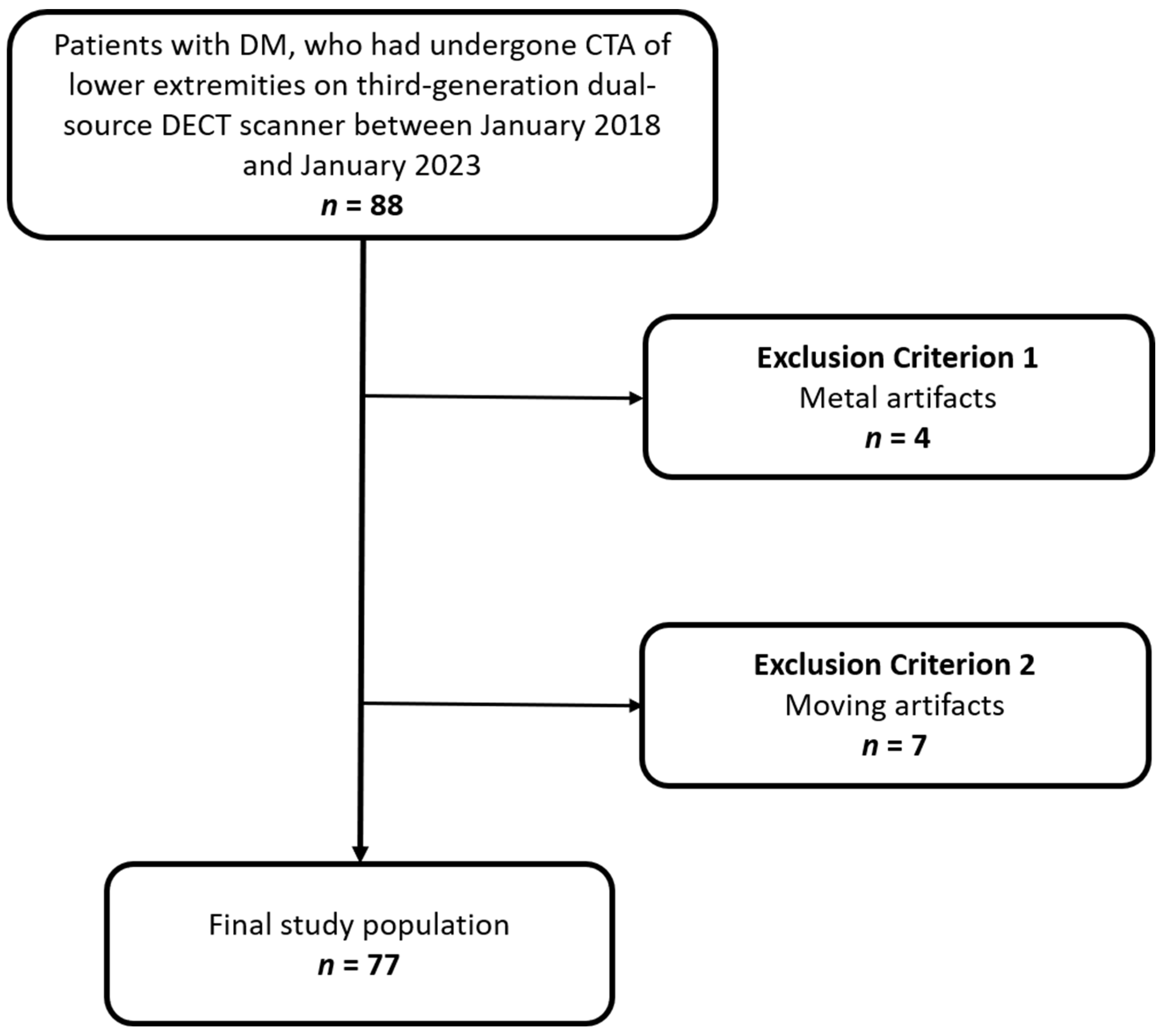
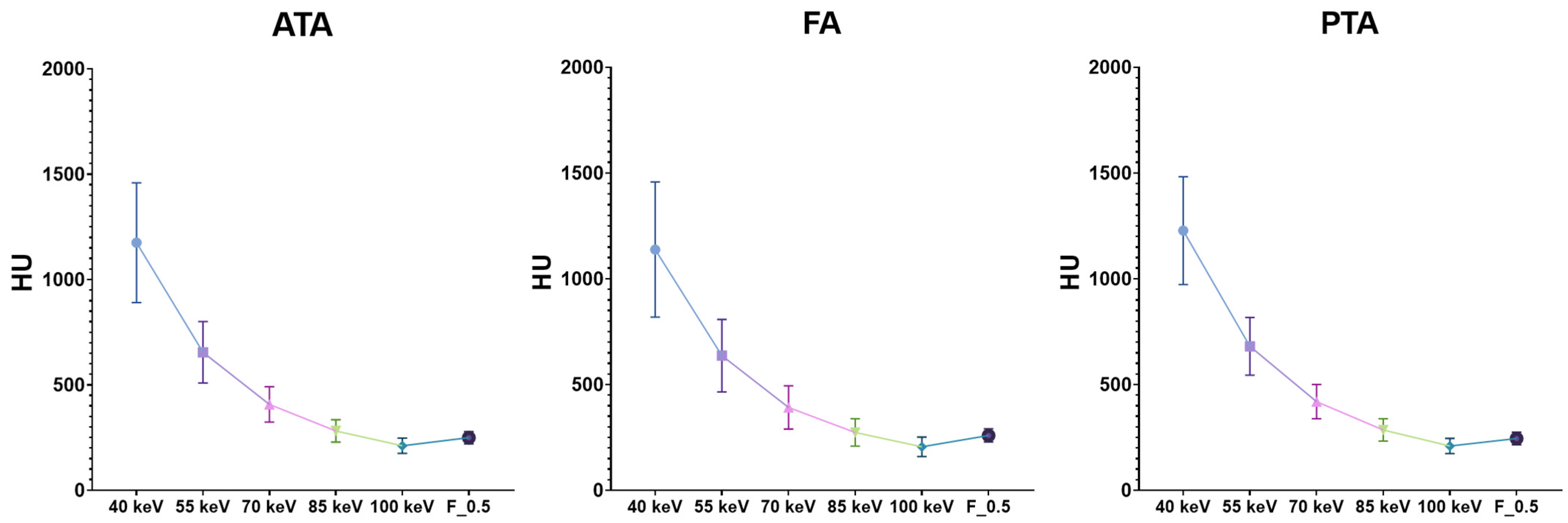
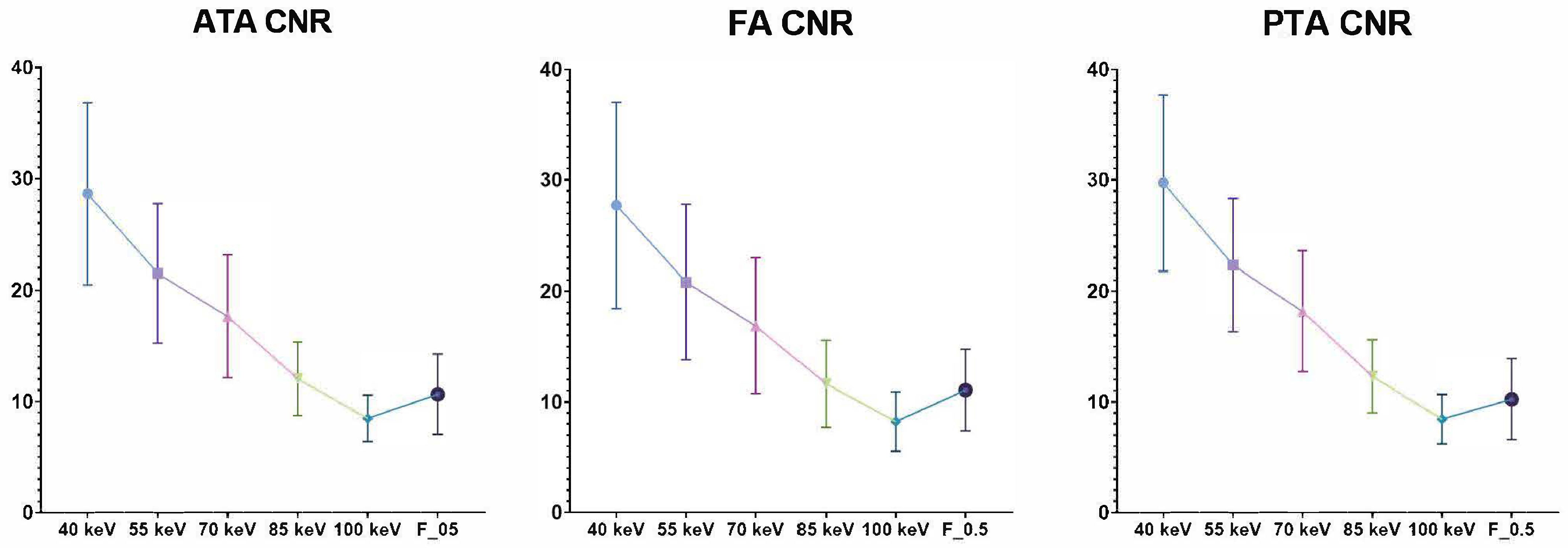

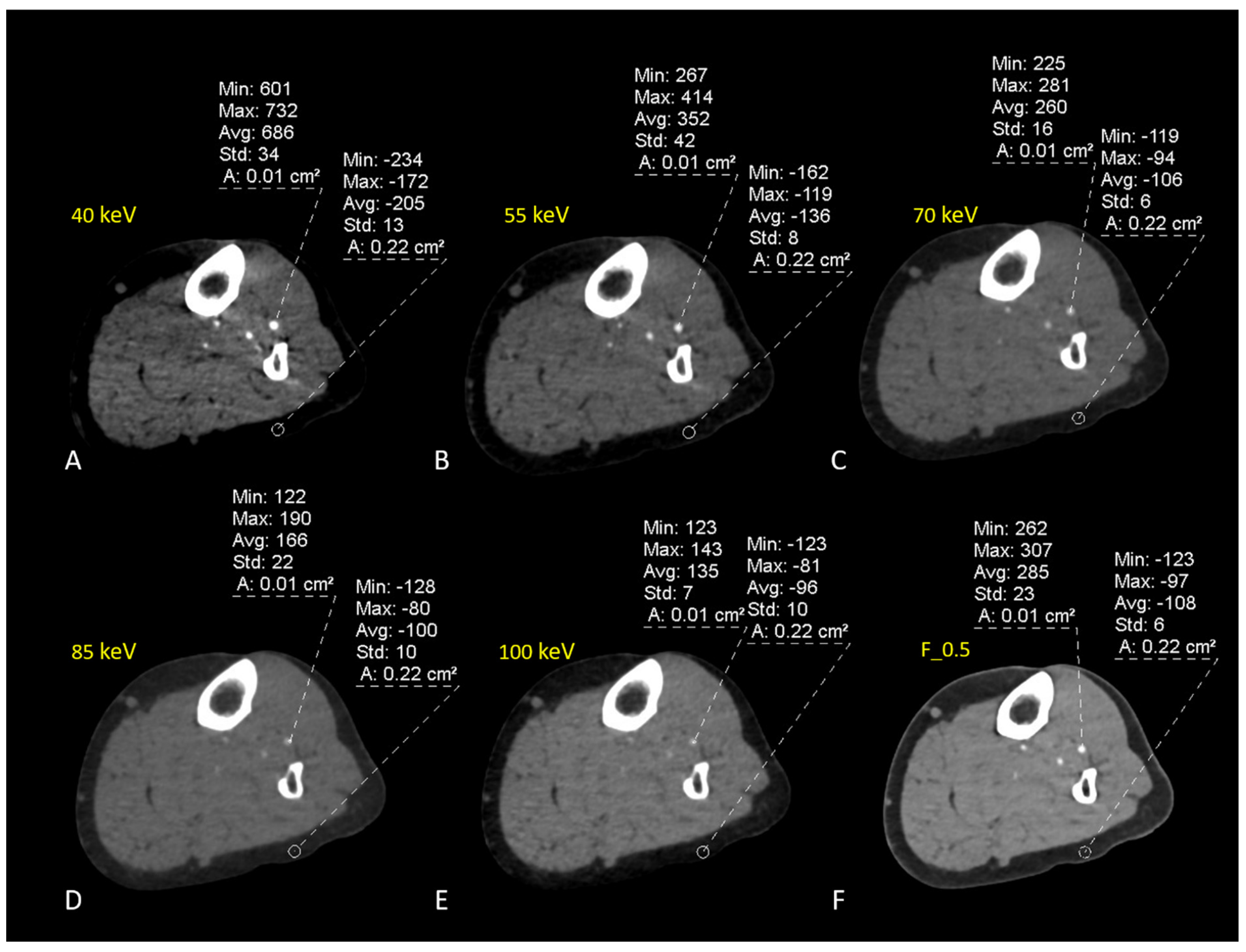
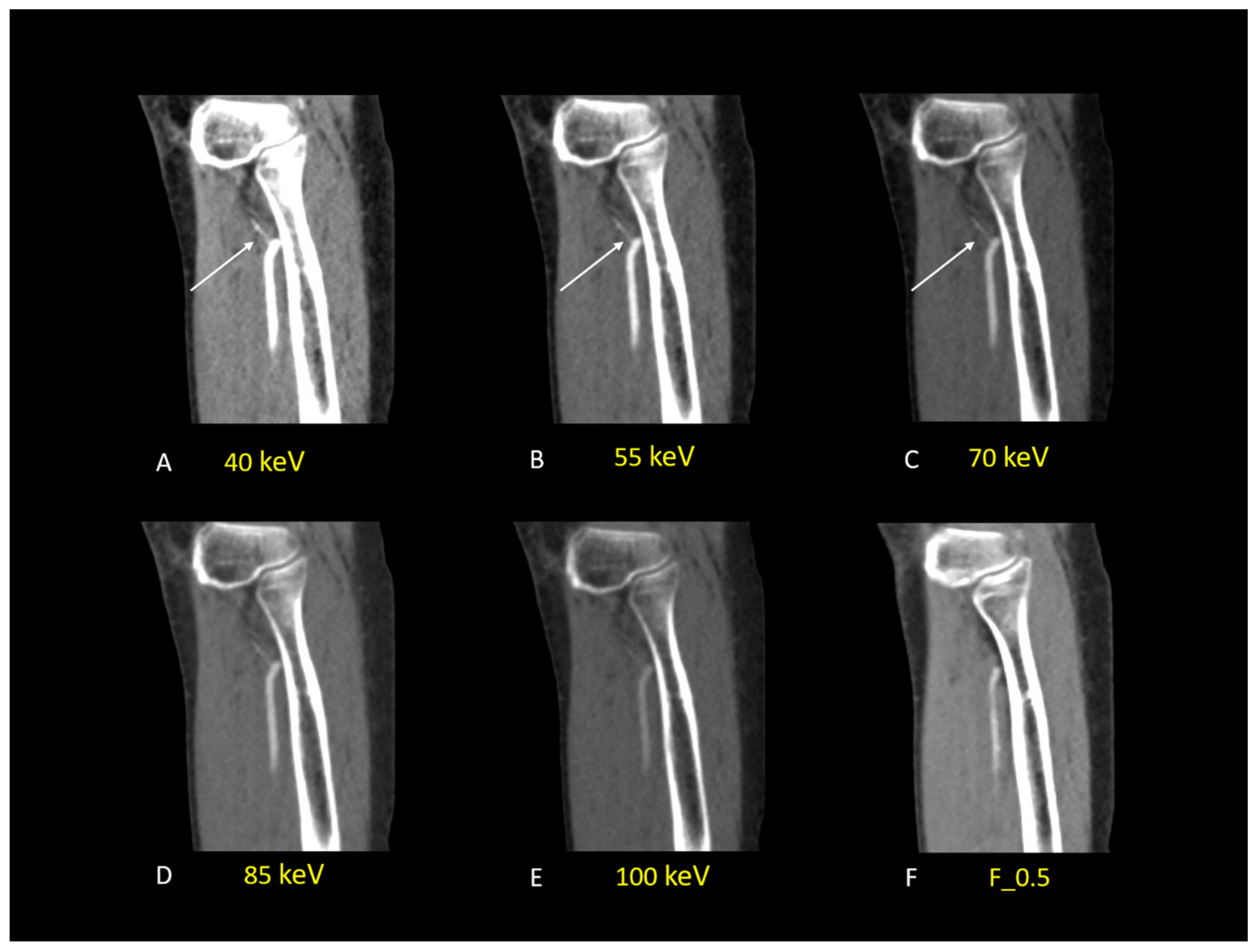
| Image Quality | Image Noise | Vessel Contrast | |
|---|---|---|---|
| 1 | Very poor | Major noise | Not diagnostic |
| 2 | Poor | More than average noise | Poor |
| 3 | Acceptable | Average noise | Acceptable |
| 4 | Good | Minor noise | Good |
| 5 | Optimal | None | Optimal |
| Patient Demographics | |
|---|---|
| Characteristic | All Patients (n = 77) |
| Sex, no. (%) | |
| Male | 41 (53%) |
| Female | 36 (47%) |
| Mean age; SD (y) | 79.17 ± 6.46 |
| Male | 78.93 ± 6.05 |
| Female | 79.44 ± 6.99 |
| Diagnosed Comorbidities | |
| Peripheral arterial disease | 34 (44%) |
| Hypertension | 43 (56%) |
| Kidney Insufficiency | 16 (20%) |
| Coronary artery disease | 23 (30%) |
| Previous myocardial infarction | 9 (12%) |
| Parameters | 40 keV | 55 keV | 70 keV | 85 keV | 100 keV | F_0.5 |
|---|---|---|---|---|---|---|
| Attenuations | ||||||
| ATA | 1174.97 ± 284.23 | 654.73 ± 145.84 | 407.39 ± 84.02 | 281.43 ± 53.06 | 210.85 ± 36.14 | 249.43 ± 29.08 |
| FA | 1138.28 ± 319.33 | 636.71 ± 171.39 | 391.74 ± 102.12 | 273.76 ± 64.78 | 205.94 ± 46.09 | 259.21 ± 31.21 |
| PTA | 1227.97 ± 254.92 | 681.01 ± 136.60 | 419.15 ± 80.77 | 285.62 ± 52.81 | 209.79 ± 35.89 | 245.33 ± 29.95 |
| Average all vessels | 1180.41 ± 45.09 | 657.48 ± 22.28 | 406.09 ± 13.75 | 280.27 ± 6.01 | 208.86 ± 2.58 | 251.32 ± 7.13 |
| Noise | 40.34 ± 5.72 | 28.97 ± 5.57 | 21.36 ± 4.60 | 19.64 ± 3.25 | 19.92 ± 2.99 | 20.75 ± 5.48 |
| SNR | ||||||
| ATA | 29.84 ± 8.32 | 23.22 ± 6.57 | 20.02 ± 5.96 | 14.52 ± 3.60 | 11.01 ± 2.42 | 13.25 ± 4.34 |
| FA | 28.95 ± 9.35 | 22.55 ± 7.21 | 19.27 ± 6.45 | 14.14 ± 4.16 | 10.75 ± 2.95 | 13.64 ± 4.38 |
| PTA | 30.94 ± 8.04 | 24.06 ± 6.27 | 20.56 ± 5.87 | 14.82 ± 3.53 | 10.96 ± 2.55 | 12.77 ± 4.33 |
| Average all vessels | 29.91 ± 0.99 | 23.28 ± 0.76 | 19.95 ± 0.65 | 14.49 ± 0.34 | 10.91 ± 0.14 | 13.22 ± 0.44 |
| CNR | ||||||
| ATA | 28.55 ± 8.22 | 21.42 ± 6.31 | 17.59 ± 5.54 | 12.15 ± 3.35 | 8.54 ± 2.14 | 10.54 ± 3.36 |
| FA | 27.60 ± 9.24 | 20.71 ± 7.00 | 16.83 ± 6.20 | 11.76 ± 4.00 | 8.28 ± 2.72 | 10.98 ± 3.45 |
| PTA | 29.65 ± 7.90 | 22.26 ± 6.02 | 18.13 ± 5.52 | 12.41 ± 3.34 | 8.46 ± 2.27 | 10.20 ± 3.57 |
| Average all vessels | 28.60 ± 1.03 | 21.46 ± 0.78 | 17.52 ± 0.66 | 12.10 ± 0.33 | 8.42 ± 0.13 | 10.57 ± 0.39 |
Disclaimer/Publisher’s Note: The statements, opinions and data contained in all publications are solely those of the individual author(s) and contributor(s) and not of MDPI and/or the editor(s). MDPI and/or the editor(s) disclaim responsibility for any injury to people or property resulting from any ideas, methods, instructions or products referred to in the content. |
© 2023 by the authors. Licensee MDPI, Basel, Switzerland. This article is an open access article distributed under the terms and conditions of the Creative Commons Attribution (CC BY) license (https://creativecommons.org/licenses/by/4.0/).
Share and Cite
Bucolo, G.M.; D’Angelo, T.; Yel, I.; Koch, V.; Gruenewald, L.D.; Othman, A.E.; Alizadeh, L.S.; Overhoff, D.P.; Waldeck, S.; Martin, S.S.; et al. Virtual Monoenergetic Imaging of Lower Extremities Using Dual-Energy CT Angiography in Patients with Diabetes Mellitus. Diagnostics 2023, 13, 1790. https://doi.org/10.3390/diagnostics13101790
Bucolo GM, D’Angelo T, Yel I, Koch V, Gruenewald LD, Othman AE, Alizadeh LS, Overhoff DP, Waldeck S, Martin SS, et al. Virtual Monoenergetic Imaging of Lower Extremities Using Dual-Energy CT Angiography in Patients with Diabetes Mellitus. Diagnostics. 2023; 13(10):1790. https://doi.org/10.3390/diagnostics13101790
Chicago/Turabian StyleBucolo, Giuseppe Mauro, Tommaso D’Angelo, Ibrahim Yel, Vitali Koch, Leon D. Gruenewald, Ahmed E. Othman, Leona Soraja Alizadeh, Daniel P. Overhoff, Stephan Waldeck, Simon S. Martin, and et al. 2023. "Virtual Monoenergetic Imaging of Lower Extremities Using Dual-Energy CT Angiography in Patients with Diabetes Mellitus" Diagnostics 13, no. 10: 1790. https://doi.org/10.3390/diagnostics13101790
APA StyleBucolo, G. M., D’Angelo, T., Yel, I., Koch, V., Gruenewald, L. D., Othman, A. E., Alizadeh, L. S., Overhoff, D. P., Waldeck, S., Martin, S. S., Mazziotti, S., Ascenti, G., Blandino, A., Vogl, T. J., & Booz, C. (2023). Virtual Monoenergetic Imaging of Lower Extremities Using Dual-Energy CT Angiography in Patients with Diabetes Mellitus. Diagnostics, 13(10), 1790. https://doi.org/10.3390/diagnostics13101790






